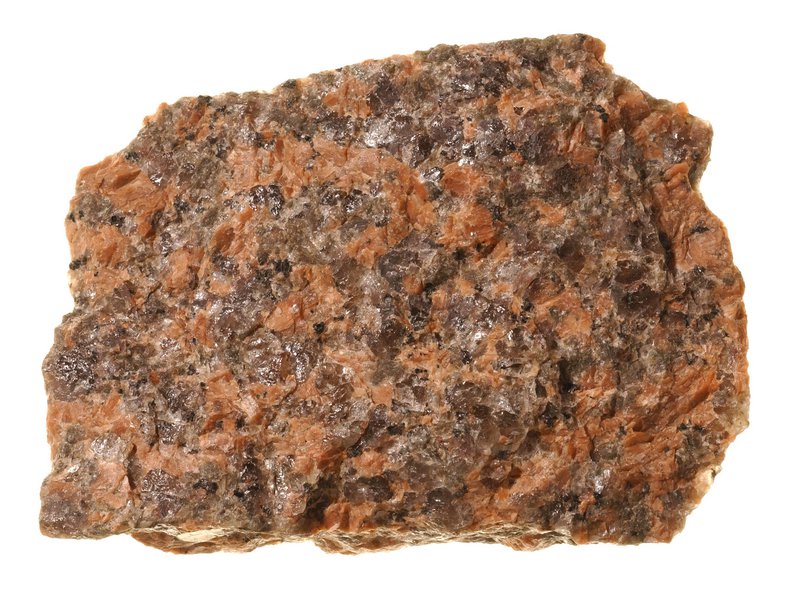Igneous rock types
These groups include plutonic, subvolcanic and volcanic rocks, which are all formed at different depths and have different grain sizes, mineral and chemical compositions.
The four main groups of igneous rocks are:
Plutonic rocks are igneous rocks that are formed deep under the Earth's surface and have a coarse grain size. They can be separated into acidic, basic and ultrabasic types, according to their mineral and chemical composition.
Acidic plutonic rocks
- Granite: the most common igneous plutonic rock. Contains essential quartz, plagioclase and alkali feldspar, usually with hornblende and/or biotite and/or muscovite.
- Granodiorite: a plutonic rock with essential quartz and plagioclase, with lesser amounts of alkali feldspar and small amounts of hornblende and biotite.
- Tonalite: a plutonic rock with essential quartz and sodic plagioclase, usually with lesser biotite and amphibole.
- Aplite: fine-grained, composed mostly of quartz and feldspars.
- Pegmatite: a very coarse-grained, usually plutonic granitic rock.
Basic plutonic rocks
- Diorite: a plutonic rock composed of sodic plagioclase, commonly hornblende, and/or biotite or augite.
- Gabbro: a coarse-grained plutonic rock with essential calcic plagioclase, pyroxene and opaque minerals, and/or hornblende or olivine. The plutonic equivalent of basalt.
- Monzonite: a plutonic rock with equal amounts of plagioclase and alkali feldspar, along with lesser amphibole and/or pyroxene.
- Syenite: a plutonic rock composed mainly of alkali feldspar, with subordinate sodic plagioclase, biotite, pyroxene, and amphibole.
Ultrabasic plutonic rocks
- Anorthosite: a plutonic rock with mostly calcic plagioclase and small amounts of pyroxene.
- Dunite: a plutonic rock composed mostly of olivine.
- Clinopyroxenite: a plutonic rock composed mostly of clinopyroxene.
- Harzburgite: a plutonic rock composed of essential olivine and orthopyroxene.
- Hornblendite: a plutonic rock composed mostly of hornblende.
- Lherzolite: a plutonic rock composed largely of olivine, along with lesser clinopyroxene and orthopyroxene, and sometimes spinel.
- Orthopyroxenite: a plutonic rock composed mostly of orthopyroxene.
- Peridotite: a plutonic rock composed of olivine with lesser pyroxene and/or amphibole.
- Pyroxenite: a plutonic rock composed largely of pyroxene.
Subvolcanic rocks are igneous rocks that are formed at medium depths and have a medium grain size.
- Dolerite: a subvolcanic rock with essential plagioclase, pyroxene and opaque minerals. The subvolcanic equivalent of basalt.
- Porphyry: a general term for igneous rocks that contain phenocrysts in a finer-grained groundmass.
Volcanic rocks are igneous rocks that are formed near the Earth's surface and have a fine grain size. They can be separated into acidic, basic and ultrabasic types, according to their mineral and chemical composition.
Acidic volcanic rocks
- Rhyolite: silicic volcanic rocks composed of quartz and alkali feldspar, with minor plagioclase and/or biotite. The volcanic equivalent of granite.
- Comendite: a porphyritic alkali-rich rhyolite with phenocrysts of quartz, alkali feldspar and sodic pyroxenes and/or amphiboles.
- Dacite: a common volcanic rock composed of quartz and sodic plagioclase, along with small amounts of biotite and/or hornblende, and/or pyroxene.
Basic volcanic rocks
- Basalt: the most common volcanic rock on Earth. Composed of essential calcic plagioclase and pyroxene, sometimes with olivine, feldspathoids or interstitial quartz.
- Andesite: an intermediate, commonly porphyritic volcanic rock composed of plagioclase, pyroxene, hornblende and/or biotite.
- Latite: an intermediate volcanic rock with equal amounts of sodic plagioclase and alkali feldspar.
- Trachyte: a volcanic rock composed largely of alkali feldspar.
Ultrabasic
- Komatiite: these rocks are high in magnesium and crystallised at high temperatures. They commonly display a spinifex texture consisting of intergrown skeletal and bladed olivine and pyroxene crystals in a glassy groundmass. Most are Archean in age.
Other volcanic rocks
Other common volcanic rocks include:
- Agglomerate: a rock of coarse pyroclastic material consisting dominantly of rounded fragments.
- Amygdaloidal: a volcanic rock containing mineral-filled cavities (or vesicles).
- Bomb: a volcanic projectile with an average diameter greater than 64 mm and whose shape or surface indicates that it was partially or completely molten during its formation and transport through the air.
- Ignimbrite: a pyroclastic tuff consisting of crystal and rock fragments in a matrix of glass shards that are usually welded together.
- Obsidian: a volcanic glass that is commonly dark in colour and glassy, with a water content less than 1%.
- Perlite: volcanic glass that exhibits numerous concentric cracks. Some are high in water and expand when heated.
- Pumice: a pyroclastic glassy volcanic rock containing abundant empty cavities (or vesicles), usually of rhyolitic composition.
- Scoria: a pyroclastic volcanic rock containing abundant empty cavities (or vesicles), usually of basaltic composition.
- Carbonatite: volcanic or subvolcanic rocks composed mostly of primary carbonate minerals, such as calcite, dolomite or Na-carbonates.
- Kimberlite: a volcanic or subvolcanic rock composed largely of serpentinised olivine, with variable amounts of phlogopite mica, orthopyroxene, clinopyroxene, carbonate and chromite. Characteristic accessory minerals include pyrope garnet, rutile, monticellite and perovskite, and in some cases diamonds.
- Lamproite: a volcanic or subvolcanic rocks that are rich in potassium and magnesium, composed of unusual rare minerals such as K-Ti-richterite, priderite, wadeite, jeppeite, Fe-orthoclase and leucite. The hostrock for diamonds in the AK1 pipe of the Argyle diamond mine, Western Australia.
- Lamprophyre: a name for a group of subvolcanic rocks that are strongly porphyritic in mafic minerals such as biotite, amphiboles and pyroxenes in a groundmass of feldspar. They commonly occur as dykes.
Reference
Le Maitre, R.W., 1989. A classification of igneous rocks and glossary of terms. Blackwell Scientific Publications, 193p.
Terms used on this page
- Acidic: rocks with above 63% silica (mostly feldspar minerals and quartz), e.g. granite.
- Basic: rocks that are about 45 to 55% silica (mostly mafic minerals plus plagioclase feldspar and/or feldspathoid minerals), e.g. basalt.
- Ultrabasic: rocks that are usually less than 45% silica (mostly mafic minerals such as olivine and pyroxene), e.g. peridotite.
- Felsic: rocks that contain mostly feldspar minerals and quartz, e.g. granite.
- Mafic: rocks that contain mostly pyroxenes and olivine plus plagioclase feldspar and/or feldspathoid minerals, eg. basalt.
- Pyroclastic: rocks made up of fragmented materials from volcanoes.


